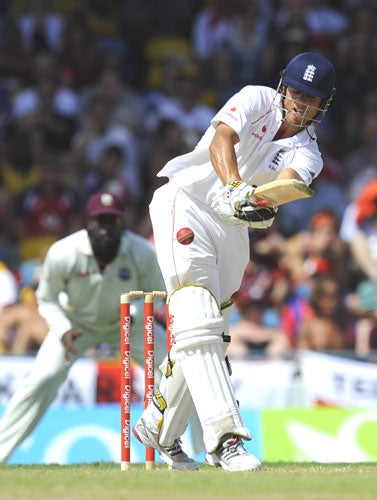Tony Cozier: 'Prof' the pitch guru caught out by flat-track Oval

"Kensington Oval will produce a typically fast, bouncy pitch over the next five days," the Daily Nation proclaimed yesterday morning.
It was reporting the confident prediction of the ground supervisor, Richard Edwards, the former West Indies fast bowler universally known hereabouts as "Prof" and regarded as something of a pitch guru. He is generally correct in his pre-match assessment, but it did not take long to realise that he had got it wrong this time. Andrew Strauss and Chris Gayle certainly knew it.
As soon as the coin rolled across the hard, flat surface and landed with heads face up, the England captain beamed as if his Lottery numbers had come up. Gayle glumly confirmed that he was also looking forward to batting: he was now left to anticipate the same long, hard grind in the sun as in the previous Test at the Antigua Recreation Ground.
Within a quarter of an hour, as Strauss and Alastair Cook settled in, it was clear that this was a clone of the Kensington pitches of an earlier generation.
All six Tests between 1955 and 1974 were high-scoring draws. In that time, the little Pakistani Hanif Mohammed and the stylish Jamaican Lawrence Rowe helped themselves to triple-hundreds. There were eight doubles, one each for the Australian openers Bob Simpson and Bill Lawry in an opening stand of 382 in 1965 – and that against an attack comprising Wes Hall, Charlie Griffith, Garry Sobers and Lance Gibbs, all knowingly watching on yesterday from the main stand. Those were the days when "Prof" had to battle as back-up to Hall and Griffith for Barbados.
Cheesed off by such batting domination and emboldened by the emergence of a raft of formable Barbados and West Indies fast bowlers, the authorities did something about it.
The story goes that when Geoff Boycott returned in 1981, he was shocked to be confronted with a green tinge on the bare, brown surface on which he had enjoyed himself on his two previous visits.
"What's this, then?" he demanded of the curator at the time, the late Tommy Peirce. "It's green and it's grass," came the reply. A few days later, Boycott had his off-stump uprooted in Michael Holding's opening over that remains one of Kensington's most memorable moments.
Others came to know and fear the awesome attacks that led the West Indies attack at Kensington over the next two decades as Holding, Andy Roberts, Joel Garner, Colin Croft, Malcolm Marshall and others consistently wreaked havoc.
Between 1978 and 1997, there were 16 outright results. Fourteen were West Indies victories.
The fire of the West Indies attacks and the green of Kensington pitches faded. Once their fortress, the ground has fallen to recent invaders five times in the last five Tests.
They now operate with only two bowlers of Test standard, Jerome Taylor and Fidel Edwards. The latter was the only one who could get any life out of yesterday's unforgiving surface, unlucky to have Strauss missed on a straightforward slip catch at 58 and hurrying both batsmen with his bouncers.
But, in spite of his unplayable yorker that finally upended Strauss, it was once more evident that Daren Powell (average per wicket 46) is an inadequate back-up while Sulieman Benn, the tall left-arm spinner, has not adapted to conditions. Gayle and Ryan Hinds are makeshift trundlers.
By their decision to limit themselves to four main bowlers, England are likely to find themselves similarly short of penetration.
Subscribe to Independent Premium to bookmark this article
Want to bookmark your favourite articles and stories to read or reference later? Start your Independent Premium subscription today.

Join our commenting forum
Join thought-provoking conversations, follow other Independent readers and see their replies